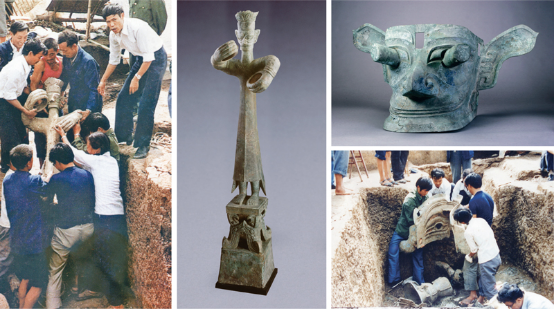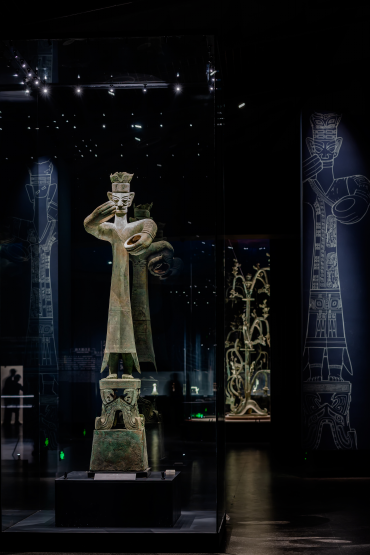Sanxingdui witnessed Chinese civilization brilliant and splendid
Author:Seeking the network Time:2022.07.25
Archaeological relics and historical relics are the testimony of history. General Secretary Xi Jinping pointed out that the major achievements of my country's archeological discovery fully show that my country has gone at the forefront of the world in the development of ancient civilization in various eras such as the Neolithic era, the bronze era, and the iron era. The number of cultural relics unearthed in the Sanxingdui site, the number of cultural relics, the large shape, the strange shape, and the rich cultural connotation.

The Sanxingdui site located in Guanghan, Sichuan was found in 1927, and the ruins were equivalent to the time of the late Xia Dynasty to Shang and Zhou. In 1986, two sacrifice pits were excavated in the site sacrifice area. There were 1,720 precious cultural relics such as golden sticks, masks, copper altars, god trees, portraits, masks, jade rituals, ivory carvings, etc. Mysterious veil. In 2020, the newly discovered the newly discovered the late sacrifice pits of the five business offices of the Sanxingdui site, which is of great significance to further reveal the cultural appearance and value of the ancient Shu civilization, and continuously deepen the understanding of the historical process of the formation of a diverse Chinese civilization. The picture shows the excavation site of the Sanxingdui Site 1 and 2 of the Sanxingdui site in 1986, as well as the unearthed copper Portrait portrait and copper longitudinal mask. Photo confession of the Sichuan Provincial Institute
"Guanghan Famous District, the old soil of the city ... It is east of the Wanwan, and its west is accompanied by the moon." The three undulating loess piles in the southern end of the central area and its northern shape, like the moon bay platform, form a well -known landscape of Guanghan, "Samsung with the moon".
In 1929, a peasant accidentally discovered more than 400 fine jade artifacts when he dotted the Moon Bay in Sanxingdui, Guanghan, which promoted the excavation of the Moon Bay in 1934. The prelude to the archeology of the Sanxingdui site.
In the early 1980s, the Sanxingdui excavator uniformly named the "Sanxingdui Site" uniformly named "Sanxingdui Site" based on the information obtained in the years, and for the first time, it was conducted in installments.
In 1986, the discovery of the "sacrifice pit" of the Sanxingdui site No. 1 and 2 made the ancient Shu history legend that has been identified as authenticity since ancient times. The Sichuan Provincial Institute of Cultural Relics and Archeology and Sanxingdui Museum launched large -scale archeological exploration, trial excavation, and investigation at the Sanxingdui site and peripherals, and obtained a series of major breakthroughs -the highest -level building area of Qingguanshan platform as the "palace" nature The process of layout and construction and evolution of the city site is gradually clarified, and the installment and sequence of the site are gradually improved ...
In 2019, with the support of the "Archaeological China" major project and the "Ancient Shu Civilization Protection and Inheritance Project" organized by the Sichuan Province, the comprehensive exploration and key excavation of the Sanxingdui site started again, and major progress has been made. As of May 2022, nearly 13,000 cultural relics such as golden masks, copper squares, copper altars, and god tree patterns have been unearthed.

The picture shows the bronze portrait of the late Shang Dynasty. Map of Sanxingdui Museum Zhang Yan/Photo
Bronze Portrait, a portrait of 180 cm high and 260.8 cm in height, has a history of more than 3,000 years. It is the world's highest and most complete bronze portrait, and is known as the "king of bronze statues of the world". The portrait head is high, the arms are slightly embracing the chest, the hands are held in hollow, the feet wear the feet, and the barefoot stands on the square monster seat. The decoration on the clothes is complicated and beautiful, mainly dragon patterns, supplemented by bird patterns, insect patterns, and visual lines. The overall image of the statue is solemn and solemn. It is made of segmented casting method. According to the height, proportion, and action of real people, it has exaggerated the eyes, ears and hands. The delicateness is rare in the history of Xia, Shang and Zhou Dynasties.
The strange shape of cultural relics shows the perfect combination of the rich imagination and exquisite handicraft technology of the ancient Shu people. The bronze vertical mask that is nicknamed "Thousand Miles Eyes, Shunfeng Ears" is named after the exaggerated shape of the eyes and ears. Its volume is huge, with outstanding outlines, exaggerated features, 138 cm wide, 66 cm high. The surrealing shape makes this statue reveal the mysterious and quietness and majesty, giving people a strong sense of deterrent.
The bronze god tree No. Ⅰ was unearthed in 1986 and reached 396 cm. It consists of three parts: base, tree and dragon. The largest in the form of all bronze cultural relics. The statue of the god tree has three layers of branches and leaves, and each layer has three branches. There are a bird standing on the flowers and fruits of the three upturns. There are nine birds (that is, the sun god bird), and a drooling dragon hangs on the lower part.


The picture shows the head of the bronze man in the late Shang Dynasty. Picture of Sanxingdui Museum
A large number of gold products, jade rituals and pottery have also been unearthed in Sanxingdui sites, all showing superb technical levels. Archaeological discovery also shows that the construction of the Sanxingdui site is unique, and the distribution of functional areas such as sacrifice areas, ordinary residential areas, and handicraft workshops in the city site is in order. Many housing buildings have shown that a large number of ancestors have lived for a long time. These houses have three forms: square, rectangular, and circular, mostly rectangular and square. Its construction method is used to dig grooves on the ground, columns in the groove, with small wooden sticks and bamboo sticks as wall bones, mud with mud on both sides to become walls, and then the wall is grilled by fire. The roof has strong ancient Shu regional characteristics. These archeological discoveries show that as an important economic, political, and cultural center in the ancient Shu era, the Sanxingdui area has created a prosperous social and cultural life. General Secretary Xi Jinping pointed out: "In the history of the long -term development of civilization for more than 5,000 years, the Chinese people have created a dazzling Chinese civilization and made significant contributions to the promotion of human civilization." Fully shows the diversity and richness of Chinese civilization.
For details, please refer to: "The Vivid Examples of the Diversity of Chinese Civilization"
not
Source: Seeking.com
Planning: Wei Tianshu
Production: Zeng Jiawen
Review: Yan Yuqing
Produced: Li Da
- END -
Hansing District Power Supply Company Carrying out the "Branch Secretary of the Sub -on -site" community reception day activity
Video/Snapshot, T_100, F_JPG, M_fast Controls = Controls data-version = 1 data-vwidth = 1080 data-vHeight/ueditor/video/mp4/20220713/165770443172779.mp4 transcoding = 1 style = width: 400px
Strict investigation!From now on, Zhengzhou Traffic Police will carry out special rectification actions
